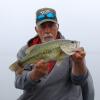Lots of good advice above, but let's concentrate on the exact question.
What you are seeing are anglers flipping directly into small openings in those massive weed beds.
These small pockets are created because there is something laying on the bottom that prohibits weed growth in those exact spots within the overall area. It could be a stump, log, rock, or simply a small outcropping of lake bottom not conducive to that type of weed such as clay or marl. The bass sit along these spots because they represent an "edge" inside of what looks like a solid mass of weeds.
Once summer hits, stand up in the bow of your boat, put on the polarized glasses, and slowly move along looking for these openings. Many are quite small and if you are moving too quickly you will run right over them. Move slowly and keep your eyes focused on the task at hand. Don't limit yourself to throwing a jig as many T-Rig soft plastics work as well.
Now that water levels in the Great Lakes are approaching record high levels, there is another place to consider on those lakes connecting to them. That is the many seawalls where there will be a narrow gap between the wall itself and the adjacent weed bed. The same principle idea here, in that the base of the wall prohibits weed growth out about 12" or so from the wall. Just like a long hole instead of a round one. For example, Spring Lake near Grand Haven contains many places where this condition exists, and you can load the boat without ever having to skip a dock. You can also find these on one of your listed "favorites", Hamlin Lake, but only in places where the weeds haven't been sprayed into oblivion.









